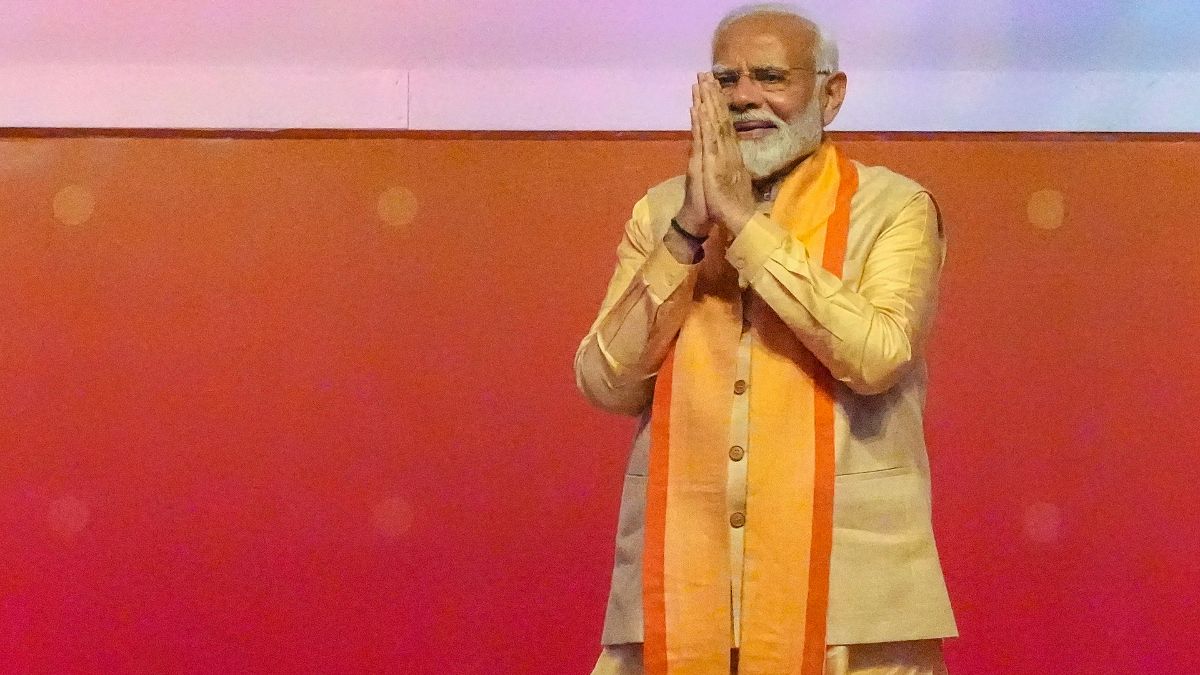The Ram Mandir’s eagerly anticipated consecration on January 22, 2024, is set to be a seminal event in the tapestry of Indian history, intertwining time-honoured traditions of the past with the robust progress of contemporary India.
The temple’s inception has brought to life the decades-old chant “Ram Lalla Hum Aayenge, Mandir Wahin Banayenge,” a powerful slogan that has echoed in the hearts and minds of millions worldwide. For Prime Minister Narendra Modi, who envisioned the Ram Mandir in Ayodhya as a young swayamsevak and is now realising this vision as the nation’s leader, this journey has been one of unwavering “faith” and “devotion”.
End of a protracted struggle
Those familiar with India’s political trajectory attest to this being the culmination of a lifelong commitment; it’s a testament to both his dedication and the unwavering commitment of millions of devoted swayamsevaks, all united in their effort to realise this historical vision.
However, there’s a long history that led to the re-establishment of the Ram Temple. A history that is deeply intertwined with a complex and longstanding dispute that epitomises the challenges of communal harmony in India.
In a landmark decision in 2019, the Supreme Court judiciously resolved this long-standing conflict. The court’s verdict not only facilitated the construction of the Ram Mandir on the contested site but also underscored the importance of balance and equity by allocating a separate area for the erection of a mosque.
This judgement was more than a legal resolution; it represented a pivotal moment in India’s ongoing journey towards communal harmony and mutual respect. By addressing the complex interplay of history, religion, and modern legal principles, the verdict aimed to pave a path forward that honours the diverse tapestry of Indian society.
Set to open its doors on January 22, 2024, the Ram Mandir heralds a significant moment in Indian history, ending a saga that has stretched over five centuries. This journey has been fuelled by the unwavering commitment of numerous devotees, who have longed to restore this sacred site, once lost to external forces.
Universal appeal of Lord Ram’s teachings
The Supreme Court’s historic decision to greenlight the construction of the temple marked the end of this protracted struggle, a narrative reminiscent of Lord Ram’s own period of exile and eventual return to Ayodhya. This mirrors the city’s prolonged anticipation for its spiritual rejuvenation.
The reconstruction of the Ram Mandir transcends its role as a mere religious edifice; it represents a confluence of faith, unity, and a celebration of India’s rich civilisational heritage. It signals the dawn of a new chapter of hope and spiritual awakening. Every brick laid in the temple, imbued with devotion and reflective of India’s renewed spirit, contributes to this historic monument. It stands not only as a place of worship but also as a symbol of the collective aspirations and rejuvenated spirit of India.
Beyond its religious significance, the temple underscores the combined strength of Vikas (development) and Virasat (heritage), propelling the nation forward. The upcoming consecration event is set to draw attendees from across the world, underscoring India’s rich heritage and the universal appeal of Lord Ram’s teachings, which transcend religious barriers. It reiterates India’s status as a guardian of old wisdom and cultural legacy; the temple complex would strengthen India’s soft power.
The re-establishment of the Shri Ram Janmabhoomi Temple transcends national and religious confines, holding profound significance globally. It is part of a larger strategy to foster national unity and a cultural renaissance. Further, it stands as a testament to faith, unity, and the continuity of civilisation, differing from other monuments in its profound emblematic representation.
Ethos of ‘Vasudhaiva Kutumbakam’
Rooted in the heart of Ayodhya, the Ram Mandir not only represents a revered place of worship but also stands as a profound embodiment of the timeless principles of Sanatan Sanskriti. It is a striking manifestation of Dharma (righteousness) and Nyaya (justice), the foundational pillars of Sanatan Sanskriti. Embracing the ethos of ‘Vasudhaiva Kutumbakam’ (the world is one family), the temple resonates with the philosophy of universal kinship and environmental guardianship, reflecting a worldview that transcends mere religious practices to encompass a more holistic understanding of our interconnected existence.
In today’s world, where global challenges often blur geographical boundaries, the teachings of Sanatan Dharma, as embodied by the Ram Mandir, provide a valuable blueprint for sustainable living and peaceful coexistence. The temple, honouring Lord Ram, an exemplar of virtue and moral rectitude, stands as a beacon of the ethical and spiritual values championed by the Sanatan tradition. Its presence in Ayodhya is a continuous reminder of the need for a moral compass to guide societal development and foster a sense of global community, reminding us of the enduring relevance of ancient wisdom in contemporary times.
“Daihik daivik bhautik tapa, Ramraj nahin kahuhi byapa……Nahin Daridra kou dukhi na dina, Nahin kou abudh na lakshan hina….!”
The concept of ‘Ram Rajya’, revered in Indian culture, epitomises an ideal state characterised by justice, equality, universal brotherhood and the welfare of all, resonating with the aspirations of modern democracies and welfare states.
This vision, eloquently articulated by poet-saint Tulsidas, envisages a society free from suffering where every individual is nurtured and cared for. In Ramcharitmanas, Lord Ram exemplifies this ideal, representing the essence of democratic values, dignified conduct, and societal welfare. His just and prosperous reign in Kosala serves as a timeless model for virtuous governance.
The Ram Mandir, thus, stands as a symbol of these enduring principles, bridging the gap between ancient wisdom and contemporary societal values. Its significance, heightened by the global attention it garners, especially with the upcoming consecration ceremony, reaffirms its status as a monument of historical and cultural importance.
This temple not only represents the age-old ideal of ‘Ram Rajya’ but also resonates with the principles outlined in the Indian republic’s constitution, mirroring the ethos of an ancient Bharatiya republic redefined within a modern constitutional framework. This fusion of traditional values and contemporary governance, championed by figures like Mahatma Gandhi and Pandit Deen Dayal Upadhyay, continues to inspire a balance between ethical leadership and societal welfare.
Nav Kalyanvaad
Under Prime Minister Narendra Modi, the Indian government has embarked on a journey of Nav Kalyanvaad (new welfarism), echoing the principles of ‘Ram Rajya’. Initiatives such as the Pradhan Mantri Jan Dhan Yojana, a financial inclusion programme, embody the principle of economic empowerment by providing access to banking services for the unbanked. Similarly, the Ayushman Bharat programme, offering health insurance to the underprivileged, echoes the Ram Rajya tenet of healthcare for all. Swachh Bharat Abhiyan, aimed at improving sanitation and cleanliness, aligns with the ideal of a pure and healthy environment. Additionally, the Pradhan Mantri Awas Yojana’s focus on affordable housing reflects a commitment to ensuring a dignified life for every citizen, resonating with the shelter for all ideals of Ram Rajya.
Moreover, Modi’s governance extends these principles to various other sectors. The Saubhagya Scheme, focusing on rural electrification, symbolises the equitable distribution of resources, a core value of Ram Rajya.
In the realm of employment and self-reliance, initiatives like Skill India and Startup India encourage skill development and entrepreneurship, resonating with Ram Rajya’s emphasis on self-sufficiency and prosperity.
The government’s policies emphasise empowering the marginalised sections of society, resonating with the teachings of Mahatma Gandhi and Pandit Upadhyay. The PM-KISAN scheme, supporting India’s agrarian community, underlines the importance of nurturing and protecting the primary providers of sustenance, aligning with the nurturing aspect of Ram Rajya.
The Modi government has embraced digitalisation with open arms. The Digital India campaign and a push towards e-governance are steps towards reducing corruption and enhancing transparency in governance, resonating with the ancient ideal of a just and transparent administration. Ujjwala Scheme, Beti Bachao, Beti Padhao campaign and Nari Shakti Vandan Act etc aim to empower Matrishakti.
Collectively, these programmes under Modi’s leadership illustrate an effort to forge a society where justice, welfare, and prosperity are not just ideals but tangible realities, reflecting the ancient virtues of Ram Rajya in a contemporary democratic framework.
PM Modi’s leadership in the Ram Mandir issue also reflects his approach to governance, which blends traditional cultural values with modern developmental goals.
His government has emphasised the development of Ayodhya as a cultural and pilgrimage hub, which aligns with his broader vision of promoting India’s cultural heritage as a cornerstone of national identity and pride.
The construction of Ram Mandir has been a pivotal factor in initiating an economic revival within the city. This resurgence is largely attributed to key development projects, most notably the Sarayu riverfront development. This ambitious project has dramatically enhanced the city’s visual appeal, turning it into a more attractive destination for pilgrims and tourists alike.
The beautification and modernisation of the riverfront have not only enriched the city’s cultural and spiritual ambiance but will also stimulate local businesses. The growth in tourism, spurred by these developments, will have a multiplicative effect on Ayodhya’s economy.
Hotels, restaurants, and shops will witness increased patronage, providing a boost to the hospitality and retail sectors. Moreover, the influx of visitors will lead to the creation of new job opportunities, benefiting the local population directly. Additionally, the development projects have included infrastructural improvements such as better roads, enhanced public facilities, and upgraded transportation links. This infrastructural upliftment not only serves the immediate needs of tourists and pilgrims but also lays the groundwork for long-term economic growth and stability in Ayodhya.
Peaceful culmination
Furthermore, the peaceful culmination of the Ram Mandir issue under Modi’s governance is significant. It demonstrates his administration’s ability to navigate complex and sensitive issues in a manner that seeks to balance legal mandates, historical contexts, and diverse religious sentiments, thus paving the way for a more prosperous, equitable, and harmonious society. This has been an important aspect of Modi’s tenure, highlighting his approach to handling India’s pluralistic and often contentious socio-religious landscape.
In conclusion, the Ram Mandir in Ayodhya stands not just as a religious symbol but as a beacon of India’s evolving narrative. Its construction is a harmonious blend of faith, heritage, and modernity, symbolising India’s journey towards an integrated society where ancient traditions coexist with contemporary aspirations.
The temple serves as a reminder of the nation’s ability to navigate its diverse and complex history, fostering a future where cultural identity and progress go hand in hand.
As the temple opens its doors on January 22, 2024, it will not only be a place of worship but a monument to India’s unyielding spirit, embodying the essence of Ram Rajya in its truest form.
This historic moment marks a significant milestone in India’s story, a story of resilience, unity, and the perpetual quest for harmony, guided by the principles of righteousness and justice. The day will see the streets and hearts of India illuminated, echoing the traditional Diwali festivity but with a unique resonance.
The nation will come together, transcending the usual calendar, to honour this momentous occasion, symbolising a new epoch in India’s cultural and spiritual journey.
The author is Professor in Kirori Mal College, Delhi. Views expressed in the above piece are personal and solely that of the author. They do not necessarily reflect Firstpost_’s views._
Read all the Latest News , Trending News , Cricket News , Bollywood News , India News and Entertainment News here. Follow us on Facebook , Twitter and Instagram .


)




)
)
)
)
)
)
)
)